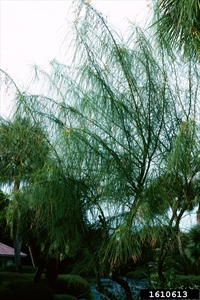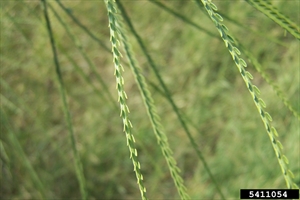- Widespread. Africa, Asia, North, South and Central America, Caribbean, Europe, Oceania. In Australia, FSM, Guam, New Caledonia.
- Invasive, large amounts of seed, tolerates range of soils, even those seasonally flooded. Found near creeks, rivers, bores and dams in semi-arid regions, but also grasslands, open woodlands, rangelands, pastures, waste areas, disturbed sites and roadside. Prevents cattle accessing water.
- Grows mostly 2-6 m, smooth, single or multi-stems that zigzag. Young stems with spines below each leaf. Leaves, up to 30 cm long, flat, green, long leaf stalks, with many, small, oblong leaflets. Flowers, up to 20 mm across with four yellow petals, and one erect orange or orange-spotted petal. Seed pods, long, straight with 1-4 seeds, occasionally more.
- Spread: suckers; seed by birds, cattle, water, vehicles.
- Biosecurity: high risk of introduction. In Australia, 'restricted invasive plant': do not release into environment, give away or sell.
- Biocontrol: two seed beetles, a leaf bug, a leaf-feeding looper have some potential.
- Cultural control: hand weeding, mechanical (use of chains, bulldozers); fire; restrict movement of sand and soil.
- Chemical control: choice of foliar, cut-basal-bark, soil or trunk treatments, depending on proximity to water, and size. In Australia: triclopyr + picloram; triclopyr + picloram + aminopyralid; picloram + aminopyralid. In Fiji, glyphosate.
Pacific Pests, Pathogens and Weeds - Online edition
Pacific Pests, Pathogens, Weeds & Pesticides
Jerusalem thorn (442)
Jerusalem thorn; It is also known as Barbados flower-fence, horse bean, jelly bean tree, or parkinsonia.
Parkinsonia aculeata. It was known previously as Mimosa bimocronata. It is a member of the Fabaceae.
AUTHORS Grahame Jackson & Aradhana Deesh
Adapted from Parkinsonia (Parkinsonia aculeata) (2018) Weeds of SE Qld and Northern NSW. Lucidcentral. (https://www.lucidcentral.org/editors-pick-animal-and-plant-identification-keys/key-to-weeds-of-se-qld-and-northern-nsw); and additional information from Parkinsonia aculata. Wikipedia. (https://en.wikipedia.org/wiki/Parkinsonia_aculeata); and CHAH (2020) Parkinsonia aculeata L. Parkinsonia. WeedsAustralia - Profiles. Department of Sustainability, Environment, Water, Population and Communitie. (https://profiles.ala.org.au/opus/weeds-australia/profile/Parkinsonia%20aculeata); and Parkinsonia: declared pest (2019) Department of Primary Industries and Regional Development. Government of Western Australia. (https://www.agric.wa.gov.au/declared-plants/parkinsonia-declared-pest); and from DAF (2020) Parkinsonia Jerusalem thorn or jelly bean tree Parkinsonia aculeata. Queensland Government. (https://www.daf.qld.gov.au/__data/assets/pdf_file/0014/55040/parkinsonia.pdf). Photo 1 Hectonichus Parkinsonia aculeata - Athens, Greece; Photo 2 John Ruter, University of Georgia, Bugwood.org; Photos 3&4 Karen A. Rawlins, University of Georgia, Bugwood.org; Photos 5&6 William M. Ciesla, Forest Health Management International, Bugwood. org.
Produced with support from the Australian Centre for International Agricultural Research under project HORT/2016/185: Responding to emerging pest and disease threats to horticulture in the Pacific islands, implemented by the University of Queensland, in association with the Pacific Community and Koronivia Research Station, Ministry of Agriculture, Fiji.









